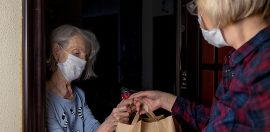A new National Strategy for Volunteering is in the works – and you can help shape it

23 May 2022 at 4:59 pm
A new survey reveals that volunteer numbers have dropped in Australia since COVID, as work gets underway on the first national strategy in a decade.
Organisations or groups that involve volunteers are urged to share their thoughts in a survey aimed at shaping the future of volunteering in Australia.
Led by Volunteering Australia, the survey is the third step in a process that will eventually see the creation of Australia’s next National Strategy for Volunteering.
This would be the first National Strategy for Volunteering in over 10 years.
The Volunteering in Australia research project has already engaged with volunteers to learn their thoughts on why they give their time and energy, and from this has produced an early insights report.
The report reveals that the number of Australians undertaking volunteer work is lower than it was before COVID, when 36 per cent of adults were estimated to have volunteered. But in the 12 months before the survey was conducted in April 2022, 26.7 per cent of Australian adults volunteered – a slight increase from 24.2 per cent in April 2021.
According to the report, the majority of those who stopped volunteering have not yet returned to the field – but they have noticed the impact on their wellbeing, reporting lower levels of life satisfaction than those who still volunteer.
The report also revealed a difference between informal and formal volunteering, with almost half (46.5 per cent) of Australian adults reporting that they had been involved in informal volunteering over the previous four weeks.
People born in a non-English speaking country were more likely to have undertaken informal volunteering than those born in Australia.
The place of volunteering in our recovery
The early insights report noted that some volunteers had not yet returned to their face-to-face roles.
Mark Pearce, CEO of Volunteering Australia, said there was still some hesitancy around returning to public-facing roles as the pandemic continued to rage.
In other cases, volunteer programs may have not yet reopened fully or at all. In other cases, people who have been unable to fill their usual volunteer role over the past two years may have found something else to occupy their time.
“One of the resounding responses we’ve seen, both anecdotally as well as in evidence – and this is both domestically and globally – is that volunteers are looking for more flexibility and choice,” Pearce explained.
“Almost half of Australians [said they had] volunteered informally, which is a fantastic figure. But then you contrast that to people who volunteer through organisations and we’re still lagging on that basis. 26.7 per cent of Australians volunteer their time through organisations, through organisations and into community.
“So that speaks to a whole lot of different things, not the least of which is that people value the opportunity to have choice and flexibility in how they participate within their community. It’s not the only takeaway, but it is a takeaway.”
He said many informal volunteers didn’t consider the work they were doing to be volunteering; rather, they considered it to simply be “helping”.
“So even some volunteers… have a different perspective, different understanding of what volunteering is,” he said. “So, yes, it’s about flexibility. Yes, it’s about choice. Yes, it’s about ensuring that there are opportunities for people… to connect to the broader community through formal volunteering.”
Without predicting the results of the survey, Pearce said he believed that some volunteering programs would need to be redesigned with this flexibility and connection in mind – especially because volunteering can help people connect with the world around them, fostering resilience and inclusion.
“Generally speaking, volunteering… can provide a deep, lasting connection to the community, thereby creating more resilient communities. And that’s resilience in terms of preparedness for disasters, in terms of response, recovery, and then moving forward in a way that doesn’t take years and years and it doesn’t cost an extraordinary amount of money to bring external resources in,” Pearce explained.
Opportunity to shape the future
Pearce said a “robust evidence base” was needed to begin the national volunteering strategy.
He said the survey would help researchers understand from an organisational perspective “how we can move forward effectively” on a national strategy.
Asked why there had been such a large gap between strategies, Pearce said it spoke to “a broader lack of awareness of the importance of volunteering”.
“To put it into the context of the broader workforce, the Australian paid workforce is about 13.4 million people. The volunteer workforce, to use that nomenclature, is about 5 million Australians who contribute their time through organisations and into community, and every year about 6.5 million Australians volunteer informally,” he explained.
“So when you start to look at those numbers… it speaks to the fact that there’s not really an understanding or awareness of the criticality of volunteering in terms of social community and economic outcomes.”
Pearce added that in the wake of the federal election, volunteering was again in the spotlight, because a number of candidates – including the high-profile teal independents and Greens – benefited from volunteer “armies”.
“Volunteering isn’t just about helping in the community for the things that we have concerns about. Volunteering is also an expression of our aspiration around our democracy, around our political system. It serves a lot of purposes,” he said.
While the Department of Social Services has provided funding for the development of the national strategy, Pearce said a number of other types of bodies were involved in the volunteering ecosystem, from corporates to philanthropists, and with strong engagement and a diverse funding structure across that ecosystem, there would not be as big a gap between this strategy and the next.
“It’s important to understand that this particular strategy will provide a blueprint for volunteering for the next 10 years, but it will be an ongoing conversation,” he said.
“It’s not going to answer every question, not by any means, and nor can it. But it needs to be a thing, a document which is implementable but also opens and supports a whole lot of conversations to improve… going forward.”
To complete the survey click here.
To learn more about the National Strategy for Volunteering project click here.








